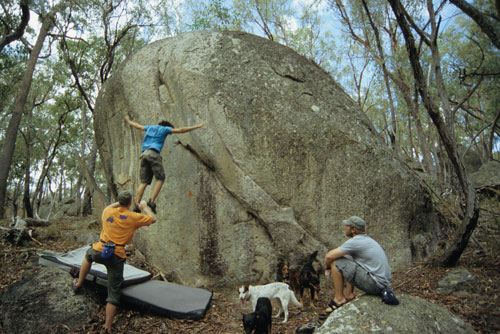Bouldering: A History
Bouldering, a form of rock climbing that focuses on short, powerful routes without the use of ropes or harnesses, has a rich and interesting history. Let's take a journey through the fun and factual aspects of bouldering:

Ancient Beginnings: Bouldering has ancient roots, with evidence suggesting that early humans engaged in some form of climbing for practical purposes like hunting and gathering. Cave paintings in locations like Spain depict people climbing and traversing rock surfaces.
Early Mountaineering Influence: Bouldering as a recreational activity began to take shape in the late 19th and early 20th centuries. The emerging sport of mountaineering played a significant role, as climbers engaged in bouldering as a means of training for larger ascents.
Fontainebleau's Influence: In the mid-20th century, Fontainebleau, a forested area near Paris, France, became a focal point for bouldering development. Climbers started exploring the unique sandstone boulders, laying the foundation for modern bouldering techniques. The iconic bleausards, local climbers, played a crucial role in shaping bouldering culture.
Crash Pads and Ethics: The 1980s saw the introduction of crash pads, which revolutionized bouldering safety. With the ability to protect falls from higher heights, climbers began pushing the limits of difficulty. This era also brought about discussions on environmental ethics, leading to the establishment of rules and guidelines to minimize impact on climbing areas.
Evolution of Grading Systems: Bouldering routes are graded based on difficulty, and various grading systems have evolved over time. The Hueco V-scale, developed in the 1990s in Hueco Tanks, Texas, became a widely adopted system in the United States. Meanwhile, the Fontainebleau scale, using numbers and letters, continues to be influential in Europe.
Competitive Bouldering: Bouldering entered the competitive scene, becoming a discipline in its own right within sport climbing competitions. The first Bouldering World Cup took place in 1998, and since then, international competitions have showcased incredible feats of strength, technique, and creativity on artificial and natural boulders.
Indoor Bouldering Boom: The late 20th century and early 21st century witnessed a surge in indoor climbing gyms, which played a pivotal role in popularizing bouldering. These facilities provided accessible and controlled environments for climbers to practice and hone their skills, contributing to the growth of the bouldering community.
Bouldering as an Art Form: Bouldering is not only a physical activity but also an art form. Climbers express themselves through movement, creativity, and problem-solving on the rock. The aesthetics of bouldering have inspired films, photography, and artistic projects, showcasing the beauty of the sport beyond its athletic aspects.
Global Community and Diversity: Bouldering has transcended cultural and geographical boundaries, creating a diverse and global community. Climbers from different backgrounds come together to share experiences, techniques, and a passion for exploration. The inclusive nature of the sport continues to foster camaraderie and friendship among enthusiasts worldwide.
From ancient rock surfaces to modern climbing gyms, bouldering has evolved into a dynamic and vibrant activity that captivates individuals with its physical challenges and artistic expression.
Some names that may be familiar to you:
-
John Gill:
- "Father of modern bouldering"
- Introduced chalk, emphasized controlled movement
- Developed training techniques in the 1950s and 1960s
-
Gillian "Gill" Peet:
- British climber
- Contributed to the development of bouldering in Fontainebleau, France
- Explored and documented sandstone boulders in Fontainebleau
-
Jerry Moffatt:
- Renowned British climber in the 1980s and 1990s
- Bold and dynamic climbing style
- Pushed the limits of difficulty in both sport climbing and bouldering
-
Fred Nicole:
- Swiss climber in the 1990s and early 2000s
- Established numerous difficult boulder problems
- First confirmed V14 (8B+) grade problem, "Dreamtime" in Cresciano, Switzerland
-
Alex Puccio:
- American climber with notable success in competitive bouldering
- Numerous national and international titles
- Contributed to the visibility and popularity of bouldering as a competitive sport, especially for women






